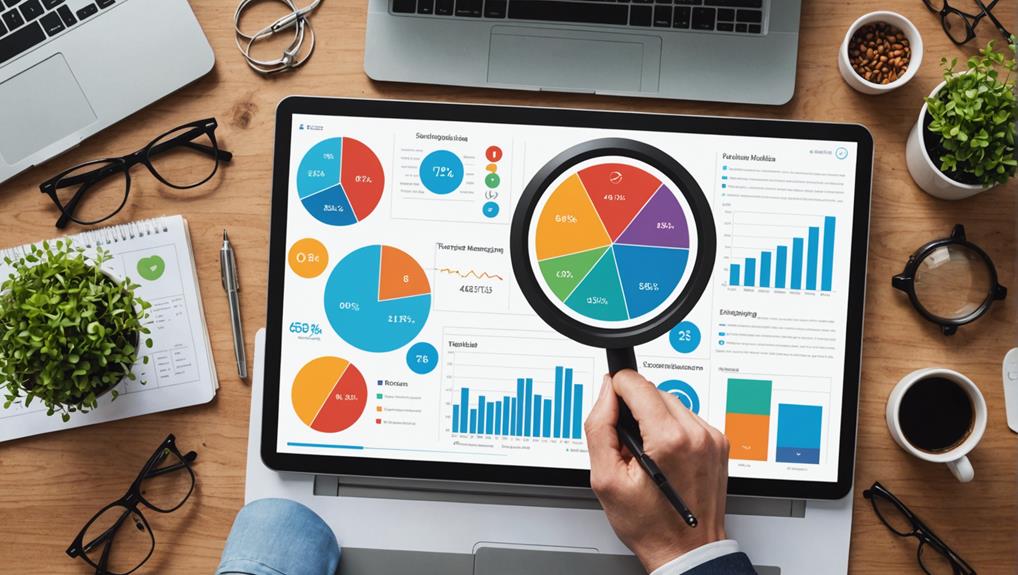Achieving LinkedIn business content success involves four vital strategies. First, define content goals by establishing SMART objectives to boost engagement rates and use analytics tools for tracking. Second, utilize LinkedIn’s features like Pages and Ads for targeted content placement and enhanced brand visibility. Third, foster audience engagement through consistent posting, leveraging rich visuals, and encouraging interaction via polls and storytelling techniques. Finally, continuously analyze performance with LinkedIn Analytics and conversion tracking to refine and optimize your strategy. Integrating these strategies effectively will not only guarantee content reaches the intended audience but also meets broader business objectives, revealing further insights.
Key Takeaways
- Establish SMART goals to create specific, measurable, and time-bound content strategies for LinkedIn success.
- Utilize LinkedIn features like Pages and Ads for enhanced brand visibility and precise audience targeting.
- Maintain consistent posting, at least once a week, to boost engagement and audience retention.
- Integrate rich visuals and storytelling to capture interest and foster deeper audience connections.
- Regularly analyze engagement metrics using LinkedIn Analytics to refine and optimize content strategies.
Define Your Content Goals
Defining your content goals is the cornerstone of successful LinkedIn business strategy, guiding every aspect of content creation and distribution. Establishing clear, SMART goals—Specific, Measurable, Achievable, Relevant, Time-bound—guarantees that your content marketing strategy aligns with desired outcomes such as brand awareness or lead generation.
For instance, 80% of B2B marketers utilize paid content to bolster these objectives, underscoring the importance of strategic planning.
Identifying your target audience is paramount, as content tailored to their interests can enhance engagement rates by up to 50%. This requires a meticulous understanding of audience demographics and preferences to craft messages that resonate.
Regular, consistent posting—ideally at least once a week—is vital, as it can effectively double engagement rates. This consistency assures that your brand remains visible and top-of-mind within your network.
Leveraging analytics tools is indispensable for tracking performance against your content goals. These tools provide insights into what strategies yield measurable success, allowing for continuous improvement.
Utilize LinkedIn Features
Harnessing the power of LinkedIn features is integral to amplifying your business content’s reach and effectiveness. LinkedIn Pages are pivotal for creating a professional hub where businesses can enhance brand awareness and share optimized content on LinkedIn. By fully optimizing these pages, companies can achieve up to 30% more weekly views, thereby improving visibility and engagement.
Post Sharing is another strategic feature, enabling employees to disseminate content across their networks, extending reach and further enhancing brand awareness. Additionally, LinkedIn Ads offer advanced targeting options that align with specific business objectives, allowing marketers to pinpoint professionals by job title, industry, or company size, leading to heightened engagement with pertinent content.
The LinkedIn Insight Tag is essential for tracking conversions, providing critical data that aids in evaluating campaign efficacy and refining future strategies. This tool guarantees that content strategies align with business objectives through informed decisions rooted in analytics.
| Feature | Benefit |
|---|---|
| LinkedIn Pages | Increases brand visibility |
| Post Sharing | Enhances content reach |
| LinkedIn Ads | Targets specific professional audiences |
| LinkedIn Insight Tag | Tracks and optimizes campaign performance |
Utilizing these features effectively guarantees that content on LinkedIn not only reaches the intended audience but also achieves the desired business outcomes.
Foster Audience Engagement
While leveraging LinkedIn’s robust features can noticeably enhance content reach and visibility, the real impact is seen when these efforts are coupled with active audience engagement strategies.
Consistent communication is paramount; posting at least once a week can double engagement rates. This regularity keeps your audience engaged and fosters a sense of community.
Utilizing rich visuals like video content can further amplify interaction, with video posts garnering five times more engagement compared to text-only updates.
Storytelling techniques are vital to connect with your audience on a personal level. Crafting narratives that address their pain points and interests can greatly boost engagement.
Additionally, encouraging audience participation through polls or questions not only enhances engagement rates but also generates a vibrant community atmosphere around your brand.
Here are key strategies to foster audience engagement on LinkedIn:
- Consistent posting: At least once a week to maintain audience interest.
- Rich visuals: Incorporate video content to increase interaction.
- Storytelling: Use narratives to connect on a personal level.
- Polls and questions: Encourage audience participation and build community.
- Responding to comments: Engage promptly to build trust and loyalty.
Responding to comments and feedback promptly is essential in building trust, making followers feel valued and more likely to contribute to future discussions.
Analyze and Improve Performance
Maximize your LinkedIn content strategy by diligently analyzing performance metrics to refine and enhance engagement. Regularly tracking engagement metrics such as likes, shares, comments, and click-through rates is vital in identifying content that resonates with your audience.
Utilize LinkedIn Analytics to monitor follower growth and assess the performance of your posts, focusing on impressions and engagement rates. This helps in gauging visibility and interaction, enabling a performance assessment that aligns with your overarching content strategy.
Implement A/B testing for different content formats and posting times to determine best strategies that improve audience engagement and maximize reach. Conversion tracking through LinkedIn Insight Tag is necessary for evaluating specific campaign effectiveness and understanding user behaviors that lead to desired website actions.
This data-driven insight is invaluable in refining strategies for better outcomes. Continuously iterating your content strategy based on data-driven insights guarantees that your content remains relevant and aligned with audience preferences and industry trends.
Frequently Asked Questions
What Content Strategy Works for Linkedin?
An effective LinkedIn content strategy prioritizes audience targeting, leveraging visual storytelling, and cultivating thought leadership. Consistent posting frequency and content curation enhance engagement. Integrating employee advocacy, industry trends, and network building guarantees brand consistency and maximizes LinkedIn engagement.
How Do I Create a Successful Content on Linkedin?
To create successful LinkedIn content, focus on engaging visuals, audience targeting, and strategic content scheduling. Utilize storytelling techniques, video marketing, and thought leadership. Enhance engagement with hashtag usage, industry insights, networking tips, and analytics tracking for data-driven refinement.
What Are Your Top 3 Best Practices of a Successful Linkedin Profile?
A successful LinkedIn profile entails profile optimization tips like maintaining branding consistency, crafting a professional headline, and an engaging summary. Prioritize skills showcase, visual elements, and industry keywords. Maximize networking opportunities through connection strategies and emphasizing recommendations importance.
How Do I Make My Business Successful on Linkedin?
To make your business successful on LinkedIn, focus on LinkedIn networking, audience engagement, and brand storytelling. Prioritize thought leadership, leverage visual content, and monitor industry trends. Implement employee advocacy, refine connection strategies, optimize content scheduling, and utilize performance analytics.
Conclusion
To sum up, achieving success with LinkedIn business content necessitates a strategic approach centered on clearly defined content goals, effective utilization of LinkedIn’s features, active fostering of audience engagement, and continuous analysis and enhancement of performance metrics. By leveraging these key strategies, businesses can create data-driven, engaging content that resonates with their target audience and drives meaningful interactions. This approach not only enhances brand visibility but also maximizes the potential for business growth and professional networking on the platform.




